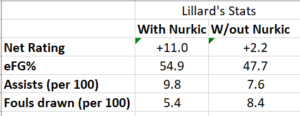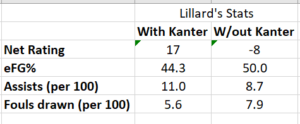
Kanter and Lillard should inspire hope for Trail Blazers fans
I’m on the record arguing that the Trail Blazers can’t win a playoff series without Jusuf Nurkic in the lineup. His broken leg functionally ended the team’s season, in my opinion.
But, if you’re hoping for optimism as the Blazers prepare for their playoff series with the Thunder, look no further than the slowly evolving Damian Lillard/Enes Kanter connection. Kanter can’t replace everything Nurkic did for the team, but so far he’s done a solid job of playing Patrick to Dame’s Spongebob.
What did Nurkic do for Lillard?
I covered Nurkic’s impact to the Blazers offense in more depth here, but suffice to say his versatility as a solid post-up player, lumbering roll man, and deft mid-range passer adds a dimension to the Blazers offense that opens the court for Lillard do his superstar thing.
The Lillard/Nurkic pick-and-roll, especially, is a thing of beauty; the duo spent the season annihilating any less-than-perfect defense:
Blazers coach Terry Stotts noticed this rapport and took advantage — Nurkic played 1884 minutes this season with Lillard on the court, but only 93 minutes while Lillard rested.
Nurkic’s presence had a noticeable positive impact on Lillard’s play (source:stats.nba.com):

Lillard’s increased shooting efficiency and assist numbers, coupled with lower fouls drawn paint a picture of a player who was forced less often to resort to one-man offense. Nurkic relieved pressure on Lillard to do it all himself.
Lillard’s shooting efficiency suffered all over the court when Nurkic went to the bench, most notably in the restricted area (10.6 percent decline) and on above-the-break 3-pointers (5.2 percent decline).
What has Kanter done for Lillard?
The good news, for Blazers fans, is that Kanter has replicated some of Nurkic’s rapport with Lillard.
In nine games since Nurkic’s injury, Kanter has played 219 minutes with Lillard, and only 15 without him. Lillard has seen a bump in net rating and assists and a decrease in fouls drawn with Kanter on the court:

Kanter’s 18.1 points per game on 61.5 percent shooting since Nurkic’s injury do some to be meshing well with Lillard, generally, and assuming some of the offensive responsibility.
Room for improvement?
With that said, Kanter still needs to adjust to Portland’s offense to optimally facilitate Lillard’s scoring punch. Dame’s decreased eFG% with Kanter on the court is at least partially a reflection of Kanter’s penchant for hanging out near the rim, clogging up lanes and making inside scoring more difficult for guards, and inability to draw defensive attention when he’s more than about five feet from the hoop:
Kanter also doesn’t have Nurkic’s high post playmaking ability. Nurkic had an assist rate of 16.8 percent while Kanter is at only 6.1 percent as a starter. He often overlooks open shooters that Nurkic would find:
Example: Nurkic makes the pass for the open corner 3. Kanter doesn't even realize it's there. pic.twitter.com/TtdLc7YjRy
— Eric Griffith (@EricG_NBA) February 23, 2019
Still good sign for the playoffs
Despite the negatives, Kanter has managed to partially replicate Nurkic’s positive teamwork with Lillard. He may not have the same passing ability or range that Nurkic developed this season, but getting 18 points per game from a starting center still adds another dimension to the offense. Kanter probably won’t be able to do enough to swing a playoff series, but he’s at least providing some optimism.
